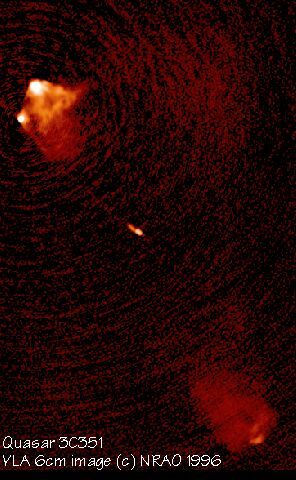Radio Quasar 3C351
Description
This image shows the radio emission from relativistic streams of high energy particles generated by the quasar. Astronomers believe that the jets are fueled by material accreting onto a super-massive black hole at the center of the host galaxy (not shown in this image). The high energy particles are confined to remarkably well collimated jets, and are shot into extragalactic space at speeds approaching the speed of light, where they eventually balloon into massive radio lobes. The overall linear size is 230/h kpc (Hubble constant H = 100h km/s/Mpc). The lobes are faint and very extended, and there are unusually prominent hot spots and filaments in the North lobe. The jet is bright near the nucleus, but much fainter in the outer regions.
FR II quasar at z=0.371. VLA 4.9 GHz image at 0.37 arcsec resolution
Creator
Legacy Astronomical Images
Rights
NRAO/AUI/NSF does not hold full copyright for this image. Contact the archivist for details.
Type
Legacy Astronomical Image
Object Name
3C351
Investigators
Alan H. Bridle, David H. Hough, Colin J. Lonsdale, Jack O. Burns, Robert A. Laing
Telescope
Very Large Array (VLA)
Observation Date
1986-03-29
Type of Observation
continuum
Band
C
Wavelength
6 cm
Frequency
5.0 GHz
Center of Image
RA 17:4:41.440, Dec: 60:44:30.400 (J2000)
Field of View
0.020000 x 0.010000 degrees
Link to journal article
Series
Active Galactic Nuclei Series
Unit
Quasars Unit
Citation
Legacy Astronomical Images, “Radio Quasar 3C351,” NRAO/AUI Archives, accessed April 1, 2025, https://www.nrao.edu/archives/items/show/33351.

